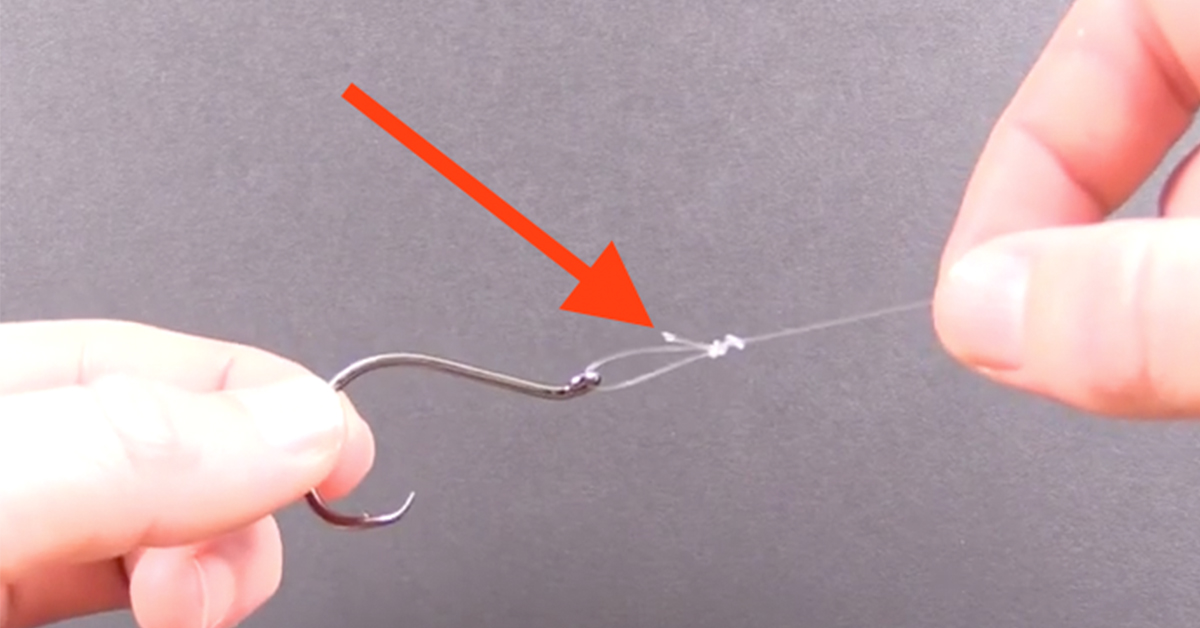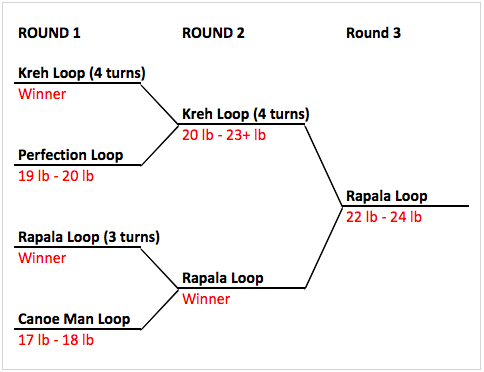The Best Loop Knot For Fluorocarbon Leader To Lure or Hook [Knot Contest]
- By: Luke Simonds
- on
- Found In: Fishing Knots, Fishing Tips, Knot Contest, Terminal Knot (Loop)

It’s Loop Knot Time!
Loop knots are extremely important to anglers who use artificial lures because they allow the baits to have the most action possible.
Since loop knots are an essential part of inshore fishing, we decided to host a “fishing knot contest” that put the top 4 most popular loop knots in a head-to-head battle so we could determine the best loop knot for fluorocarbon leader line.
Given that it can’t benefit from the 360-degree friction against the hook, the breaking strength of loop knots will be lower than most of the snug knot options. However, the added action that it provides to your lure makes it worthwhile… I highly recommend using this style whenever using artificial lures.
However, the added action that it provides to your lure makes it worthwhile… I highly recommend using this style whenever using artificial lures.
Here are the top snug knots that we tested in this fishing knot analysis:
- Kreh Loop Knot (aka: Non-Slip Loop Knot)
- Perfection Loop Knot
- Rapala Loop Knot
- Canoe Man Loop
Kreh Loop Knot (Non-Slip Loop Knot)
The ‘Kreh loop knot’ has been my knot of choice for the past 5 years once I found out about it. It’s easy to tie, has good strength, and its tag-end points down towards the lure allowing for it to be as weedless as possible.
See below for a video on how to tie it.
Note: Another name for this knot is the “Non-Slip Loop Knot”. The strength test results are shown below.
Perfection Loop Knot
I learned the ‘perfection loop knot’ years ago from a great flyfisherman (shout out to Dennis Aust) who is good friends with our family. It’s often used by fly fishermen for loop to loop connections, but it’s also very popular for tying on hooks and small lures to leader via a loop connection given its strength and ease of tying.
See video for details on how to tie the Perfection Loop Knot.
Note: Strength test results are shown below.
Rapala Loop Knot
The ‘Rapala loop knot’ is very similar to the Kreh loop knot, except that it has one added twist. The pro of this extra step is that it adds some strength to the knot. However, the downfall is that it leaves a weed-catching tag end that sticks straight up and is slightly more difficult to tie. Here’s a video that shows how to tie it:
However, the downfall is that it leaves a weed-catching tag end that sticks straight up and is slightly more difficult to tie.
Here’s a video that shows how to tie it:
Note: Strength test results are shown below.
Canoe Man Loop
The ‘Canoe Man Loop’ knot really impressed me when I first came across it… very easy to tie, strong, and the tag-end points down.
However, its strength when doing my initial tests with standard mono line did not translate over the fluorocarbon leader. Not sure why, but it scored lowest of the 4 consistently with fluoro while being one of the best with standard mono.
Here’s how to tie it in case you’re curious though:
Note: Strength test results are shown below.
CONCLUSION
Leader to Lure Loop Knot Winner
Although not quite the strongest in the category, my preference is staying with the Kreh Loop knot (aka. Non-Slip Loop knot) given that it’s easier to tie than the Rapala and that it’s tag end points directly down making it tough for those pesky weeds to ruin a presentation in front of a hungry fish.
For these line types, it’s breaking range matches exactly to the winner of the best braided line to fluorocarbon leader connection that we found in our line-to-line knot contest, so using the Kreh knot won’t cause any harm to the strength of the overall system.

This diagram shows the head to head matches that took place as part of this analysis. The test consisted of 3 rounds where the 3rd round was the winning knot tied against itself to test its strength. The red values below the names of the knots represent the amount of pull strength that the knots were able to withstand in each round.
Note: Lines used were 10 lb PowerPro braid and 30 lb Ande Fluorocarbon.
This knot testing is continuous… we’re always seeking out better styles/methods, and we will, of course, update this page as new/better knots come to light.
If you have a great leader to hook/lure knot that is not included here, please leave a comment below or send us an email – fish@saltstrong.com
We’ll include it in our next knot testing and let you know how it compares to the others.
Go To Our Knot Testing Homepage [Full Knot Rankings]
Join The Fastest-Growing Fishing Community In America!
Here’s what you’ll receive today when you join:
- Daily fishing reports and TRENDS revealing exactly where you should fish ever trip
- 20% off all fishing tackle and gear (All major brands)
- Exclusive fishing tips from the PROS you can’t find anywhere else
- Private community of fellow saltwater anglers
- Everything you need to start catching fish more consistently (regardless if you fish out of a boat, kayak, or land).
Click here to join today.
Related categories:
STOP WASTING TIME ON THE WATER!
Do what the “SMART ANGLERS” are doing and join the Insider Club.
Here’s what you’ll receive today when you join:
- Weekly fishing reports and TRENDS revealing exactly where you should fish every trip
- Weekly “spot dissection” videos that walk you through all the best spots in your area
- Exclusive fishing tips from the PROS you can’t find anywhere else
- Everything you need to start catching fish more consistently (regardless if you fish out of a boat, kayak, or land).










What does salt strong not teach us.yall are so complete and above and beyond and it is very much appreciated thank you mike justice
I like the Kreh knot the best and easiest to tie for my fingers and I like the end too be hid in the loop thanks for the suggestion Luke
Thanks, it’s time for me to switch over to this knot for inshore
@LukeSimonds – I’ve always loved the canoeman loop knot, but saw this post and see you guys seem to really like the non-slip loop knot. However, I did notice your comment about the canoeman loop knot performing very well with mono. I always use braid with a mono leader. How much of a difference is there between the canoeman and non-slip loop knots when using mono?
The difference was very small and it likely will differ based on the lines used. To see what works best for your line of choice, I recommend tying each end of short line. Then attach one end to a fixed object and pull until the weaker knot breaks.
Ok, so I tested my knot between rapala and kreh loop and perfection. On a 30lb fluoro I got a surprise. Kreh/non slip is stronger on all of my test. Perfection was way weaker I stop testing it after six knots. On a gamma Fluorocarbon 30# .50mm diameter. Rapala broke @26.6 on average. Kreh broke @ 32.8# average. On Yozuri Topknot fluorocarbon 30# .47mm diamter. Rapala broke @ 25.4# average and Kreh 29.3# average. Also found out Kreh/non slip are stronger than trilene knot on the hook. I am testing these knot to fish Tuna Offshore using live bait. I will ditched ringed hooks and will now use Kreh/non slip knot. PLine shinsei fluorocarbon are a bit stringer than gamma w same .53mm diameter. Rapala@27.05# and Kreh@35.6#.
After several test, My best combo are Suffix 832 50# FG knot to Pline Fluorocarbon (34# breaking strength) and non slip knot to mustad 39950 circle hook.
all knots are exactly the same as video above. Wet in water before pulling tight w a dowel.
Thanks for sharing your findings Ben! I’m very surprised to see that the non slip look knot beat the trilene knot.
How many wraps around the mainline do you make with your non slip loop knot?
I am afraid your Kreh Loop Knot explanantion is not only wrong, but poorly explained and shown. You put the tag end through the middle of the loop when it should be alongside the existing two lengths of nylon so that all three lengths of nylon are entering and exiting the loop on the same plane. Sorry to say this but Tightline Videos have a much better instruction.
It sounds as if you’re referring to the part after making the twists where the tag end is threaded back through the loop.
If so, our video shows the exact same tying method you described where all 3 lines are entering and exiting on the same plane… the tag end going through the middle of the loop was good because the other two lines were already there and that final move put them all together inside the loop right next to one another to complete a very good loop knot.
In our case, the method is to simply go up through the downward facing side when going up. And then to go through the upward facing side when on the way back down resulting in the lines all being on the same plane.
Luke, have you tested the surgeon’s loop as a fluorocarbon to lure or hook loop knot?
Yes, it’s a strong knot, but I prefer the non-slip loop knot because it’s easier to tie for lures and it leaves the tag end pointing back which decreases the odds of the knot snagging onto floating debris.
i see little difference in break strength between the kreh and the rapala but i do see big difference in the direction the tag end winds up pointing so i will go with the kreh
FYI, that loop shouldn’t be called the “Kreh knot.” It was not Lefty Kreh’s. He said he liked it and used it, but didn’t invent it. Not sure he knew who did.
Another name for it is the “Non-Slip Loop knot”
sorry… should mention it was 80lb black magic supple to 50lb braid in all circumstances. the biggest barra was 1 metre plus
Just know that loop knots are typically the weakest knots… their benefit is to help get more strikes by enabling better action in the water. And a secondary benefit is to at least get your leader back when there is a breakoff.
When I use 10 lb braid for the mainline and connect a 20 lb leader with the FG knot and then use a loop knot on the other end to the lure, the loop knot is the weakest link and I’m ok with that because I’ll have my drag set so that it won’t break the loop knot. But if I get hung up on some underwater structure, I’ll at least get my leader back and can be back to fishing quicker.